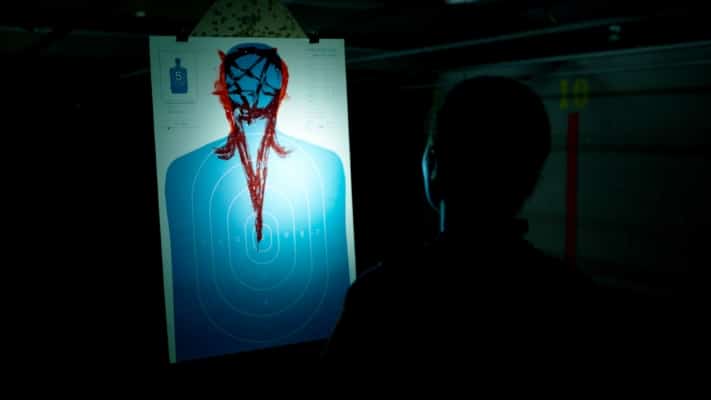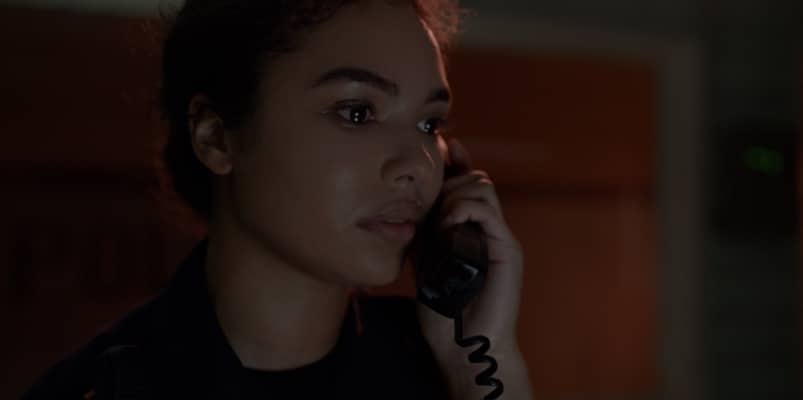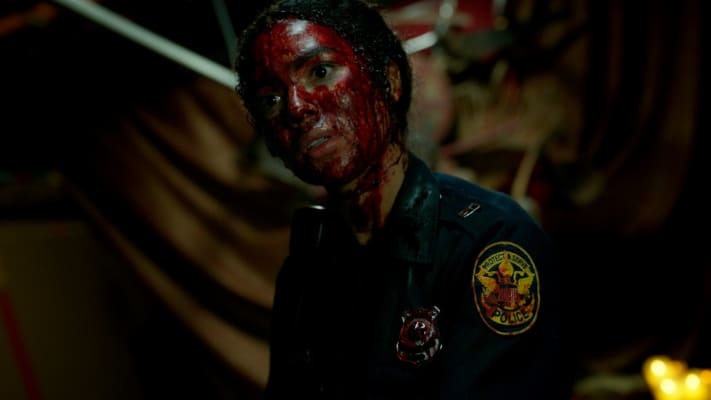Anthony DiBlasi directed and wrote – with the aid of writer Scott Poiley – a little horror film in 2014 called Last Shift. The film is for those who are into the horror genre but go past the surface level in search of something more indie and less known. That’s not to say that DiBlasi is not recognized for trying something different to this highly-loved genre. Consequently, the director applied everything from Last Shift to the remake, Malum. Malum beckoned DiBlasi and Poiley to take another crack at the story, but despite a larger budget and new cast, the movie fails to add anything new or even warrant its existence.
The concept of Malum is simple and has been done before in past horror/suspense/thriller films, but it puts a different spin on a few things. The film follows Rookie Cop Jessica Loren (Jessica Sula), assigned to the last shift of a decommissioned and possibly haunted police station. The location is significant to Jessica as it was the setting of a notoriously vicious cult’s demise by her father, the Chief of Police Will Loren (Eric Olson). However, the repercussions of Will’s questionable psychotic break would be felt across the station and town as the chief goes on a killing spree.
It’s similar to the setting of Resident Evil 2 with the vibe of Silent Hill.
 Some of the horror elements do work throughout Malum. There’s a level of creep and atmospheric dread that reflects the cold nature of the story. DiBlasi’s direction begins to amplify that notion by playing with negative space to build tension in certain scenes. In addition, a feeling of isolation ramps up the suspense element needed to keep my interest. DiBlasi also plays with sound in certain portions of the Malum to bring in the other component of impending doom.
Some of the horror elements do work throughout Malum. There’s a level of creep and atmospheric dread that reflects the cold nature of the story. DiBlasi’s direction begins to amplify that notion by playing with negative space to build tension in certain scenes. In addition, a feeling of isolation ramps up the suspense element needed to keep my interest. DiBlasi also plays with sound in certain portions of the Malum to bring in the other component of impending doom.
It works for most of the movie before it becomes tedious.
The method adds something to the story but becomes overused to justify the repeated jump scares. The trope has been done a thousand times in thousands of other horror movies and doesn’t do the movie in favor. Therefore this technique starts pissing away the “brownie points” gained by the negative space tension in the film. It might work for some horror fans, but I slowly started questioning Malum‘s art direction.
The script has moments of descent concepts like “The Sins of the Father/Mother” that start to move the plot forward. Many times throughout the movie involve Jessica, exploring and examining her father’s actions to better understand why he commented such a heinous act. The dive into the mystery takes a few turns that held my attention for half of the movie. However, the actors caused the writing to drop the ball and become a huge distraction.

The acting is stiff and wooden. The level of constraint is apparent because the cast comes off as people either reading the cue cards just out of the cameras’ sight or trying to remember their lines. William Shatner charmingly did the latter because he could. However, when the actors in Malum do it, it’s just sad. The poor acting happened so often that I started to feel dread when I discovered I had forty-five minutes left in the movie.
Lastly, some of the demon designs are well put together. The one on the poster of Malum shows up during the movie and gives it a much-needed boost in the horror department. Undoubtedly, it pairs well with a satisfying amount of blood, like a wine complementing the steak, which makes the costume design of the main demon even more perplexing. It came off like a cheaply conceived knock-off monster from the Hellraiser movies.
DiBlasi made a second attempt at Last Shift, hoping to bring something new or not fully explored with this remake. Most directors have good intentions when creating a film and expectations that will make a mark on their craft. Sadly, Malum is a failed attempt with its typical horror tropes, poor acting from his talent, and a plot twist that is in no way deserved. The creature design works in the movie except for the wannabe Cenobite, and the setting is a cool idea for this genre. However, that’s not enough to save the film.

